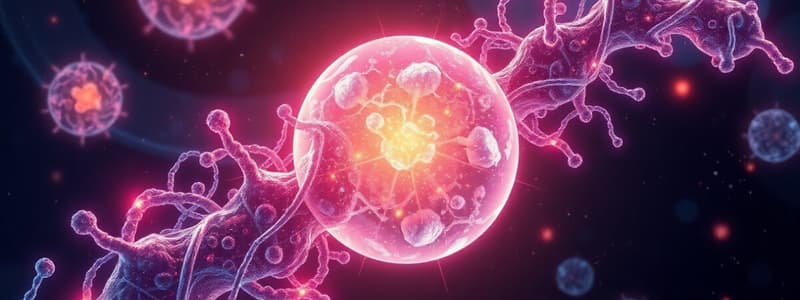Podcast
Questions and Answers
What is the primary outcome of glycolysis?
What is the primary outcome of glycolysis?
- Release of oxygen
- Production of glucose
- Anaerobic breakdown of glucose into lactic acid (correct)
- Formation of self-replicating RNA
What role does photosynthesis play in relation to Earth's atmosphere?
What role does photosynthesis play in relation to Earth's atmosphere?
- It synthesizes glucose and releases oxygen (correct)
- It releases hydrogen gas as a byproduct
- It increases carbon dioxide levels
- It creates lactic acid from glucose
Which process is responsible for breaking down glucose into CO2 and H2O, releasing energy?
Which process is responsible for breaking down glucose into CO2 and H2O, releasing energy?
- Lactic acid fermentation
- Photosynthesis
- Glycolysis
- Oxidative metabolism (correct)
How did the development of photosynthesis impact evolution?
How did the development of photosynthesis impact evolution?
Which statement is true regarding the energy yield of glycolysis compared to oxidative metabolism?
Which statement is true regarding the energy yield of glycolysis compared to oxidative metabolism?
What does the phase contrast microscope primarily enhance in observed samples?
What does the phase contrast microscope primarily enhance in observed samples?
What is the primary function of fixation in microscopy?
What is the primary function of fixation in microscopy?
Which microscopy technique is best for observing live samples without staining?
Which microscopy technique is best for observing live samples without staining?
What aspect of DIC microscopy can potentially mislead interpretation of cellular structures?
What aspect of DIC microscopy can potentially mislead interpretation of cellular structures?
What is the main disadvantage of using light field microscopy on live cells?
What is the main disadvantage of using light field microscopy on live cells?
What property of the lens is critical for the resolution limit defined for microscopy methods?
What property of the lens is critical for the resolution limit defined for microscopy methods?
Which microscopy technique uses polarized light to enhance contrast?
Which microscopy technique uses polarized light to enhance contrast?
In which microscopy technique does light pass directly through the cell?
In which microscopy technique does light pass directly through the cell?
What characteristic distinguishes Paramecium from Chlamydomonas?
What characteristic distinguishes Paramecium from Chlamydomonas?
What is the primary role of epithelial cells in the body?
What is the primary role of epithelial cells in the body?
Which type of tissue is made up of osteoblasts, chondrocytes, and adipocytes?
Which type of tissue is made up of osteoblasts, chondrocytes, and adipocytes?
What is the approximate size of Paramecium?
What is the approximate size of Paramecium?
The evolution of multicellular organisms from single-celled eukaryotes is estimated to have occurred how many million years ago?
The evolution of multicellular organisms from single-celled eukaryotes is estimated to have occurred how many million years ago?
Which of the following describes Volvox algae?
Which of the following describes Volvox algae?
What is NOT a type of animal tissue mentioned?
What is NOT a type of animal tissue mentioned?
What function is primarily associated with the cells in the salivary gland?
What function is primarily associated with the cells in the salivary gland?
What was one of Anton van Leeuwenhoek's significant contributions to microscopy?
What was one of Anton van Leeuwenhoek's significant contributions to microscopy?
Who are credited with formulating the cell theory?
Who are credited with formulating the cell theory?
What do prokaryotic cells lack compared to eukaryotic cells?
What do prokaryotic cells lack compared to eukaryotic cells?
What is the primary difference between prokaryotic and eukaryotic cells?
What is the primary difference between prokaryotic and eukaryotic cells?
Which statement is part of the cell theory?
Which statement is part of the cell theory?
What is one key concept regarding heredity in cell theory?
What is one key concept regarding heredity in cell theory?
How long ago did life emerge according to historical biological concepts?
How long ago did life emerge according to historical biological concepts?
What significant shift did the formulation of cell theory provide in scientific understanding?
What significant shift did the formulation of cell theory provide in scientific understanding?
What appearance do areas that allow greater passage of electrons have in scanning electron microscopy?
What appearance do areas that allow greater passage of electrons have in scanning electron microscopy?
Which step in histological processing comes after fixation?
Which step in histological processing comes after fixation?
What is the primary purpose of fixation in histological processing?
What is the primary purpose of fixation in histological processing?
What can cryofixation cause that may damage cell structures?
What can cryofixation cause that may damage cell structures?
What is the role of cryoprotective substances like sucrose in cryofixation?
What is the role of cryoprotective substances like sucrose in cryofixation?
In scanning electron microscopy, what is used to achieve a three-dimensional image?
In scanning electron microscopy, what is used to achieve a three-dimensional image?
Which of the following is NOT a step in histological processing?
Which of the following is NOT a step in histological processing?
How are electrons projected onto a television monitor in scanning electron microscopy?
How are electrons projected onto a television monitor in scanning electron microscopy?
What is the primary purpose of using paraffin in tissue processing?
What is the primary purpose of using paraffin in tissue processing?
Which method is used to create thinner sections for electron microscopy?
Which method is used to create thinner sections for electron microscopy?
What happens to resins during the tissue processing phase?
What happens to resins during the tissue processing phase?
Which staining agent primarily targets acidic substances in tissue?
Which staining agent primarily targets acidic substances in tissue?
In which scenario are staining steps typically unnecessary?
In which scenario are staining steps typically unnecessary?
What is the typical thickness range for sections made with a microtome for optical microscopy?
What is the typical thickness range for sections made with a microtome for optical microscopy?
What component is involved in the dehydration process during tissue preparation?
What component is involved in the dehydration process during tissue preparation?
Which of the following is a characteristic of the dyes used in optical microscopy?
Which of the following is a characteristic of the dyes used in optical microscopy?
Flashcards
Protein synthesis from RNA
Protein synthesis from RNA
The process where RNA is used to create proteins. It's essential for creating all the building blocks needed for a cell.
The First Cell
The First Cell
The first simple cell, likely consisting of only self-replicating RNA and the proteins it encoded.
Glycolysis
Glycolysis
A metabolic process that breaks down glucose without oxygen, producing lactic acid. It's a less efficient energy source than oxidative metabolism.
Photosynthesis
Photosynthesis
Signup and view all the flashcards
Oxidative metabolism
Oxidative metabolism
Signup and view all the flashcards
Hooke's drawing of cells in cork
Hooke's drawing of cells in cork
Signup and view all the flashcards
Anton van Leeuwenhoek's discoveries
Anton van Leeuwenhoek's discoveries
Signup and view all the flashcards
Cell theory
Cell theory
Signup and view all the flashcards
Prokaryotic cells
Prokaryotic cells
Signup and view all the flashcards
Eukaryotic cells
Eukaryotic cells
Signup and view all the flashcards
Spontaneous generation
Spontaneous generation
Signup and view all the flashcards
Emergence of life
Emergence of life
Signup and view all the flashcards
Biology as a historical science
Biology as a historical science
Signup and view all the flashcards
What are green algae?
What are green algae?
Signup and view all the flashcards
What is the key feature of algae?
What is the key feature of algae?
Signup and view all the flashcards
When did multicellular organisms likely first evolve?
When did multicellular organisms likely first evolve?
Signup and view all the flashcards
How do animal cells compare to plant cells?
How do animal cells compare to plant cells?
Signup and view all the flashcards
What is epithelial tissue?
What is epithelial tissue?
Signup and view all the flashcards
What is connective tissue?
What is connective tissue?
Signup and view all the flashcards
What is the role of fibroblasts?
What is the role of fibroblasts?
Signup and view all the flashcards
What are osteoblasts?
What are osteoblasts?
Signup and view all the flashcards
Scanning Electron Microscopy (SEM)
Scanning Electron Microscopy (SEM)
Signup and view all the flashcards
Electrodense Areas
Electrodense Areas
Signup and view all the flashcards
Electrolucent Areas
Electrolucent Areas
Signup and view all the flashcards
Fixation
Fixation
Signup and view all the flashcards
Cryofixation
Cryofixation
Signup and view all the flashcards
Tissue Embedding
Tissue Embedding
Signup and view all the flashcards
Sectioning
Sectioning
Signup and view all the flashcards
Staining
Staining
Signup and view all the flashcards
Light field microscopy
Light field microscopy
Signup and view all the flashcards
Phase contrast microscopy
Phase contrast microscopy
Signup and view all the flashcards
Differential Interference Contrast microscopy (DIC)
Differential Interference Contrast microscopy (DIC)
Signup and view all the flashcards
Fluorescence microscopy
Fluorescence microscopy
Signup and view all the flashcards
Confocal microscopy
Confocal microscopy
Signup and view all the flashcards
Multiphoton microscopy
Multiphoton microscopy
Signup and view all the flashcards
Tissue Preparation
Tissue Preparation
Signup and view all the flashcards
Dehydration
Dehydration
Signup and view all the flashcards
Solidification
Solidification
Signup and view all the flashcards
Paraffin
Paraffin
Signup and view all the flashcards
Resins
Resins
Signup and view all the flashcards
Hematoxylin-Eosin Staining
Hematoxylin-Eosin Staining
Signup and view all the flashcards
Study Notes
Unit 1: Overview of the cell and cell research
- Biology is the study of the composition, development, functioning, links, and distribution of living things.
- A cell is the fundamental unit of living beings that can reproduce independently.
- Cell biology is a specialized discipline focusing on cell structure, function, components, interactions, and properties. It incorporates knowledge from genetics, biochemistry, immunology, and other areas.
- Cell biology studies cells with regard to their properties, structure, functions, organelles, interactions with the environment, and life cycle.
- Molecular biology investigates the processes of living beings from a molecular perspective, focusing on macromolecules (nucleic acids and proteins). It aims to understand the interactions of cellular systems, including DNA-RNA interactions, protein synthesis, metabolism, and regulation for cellular function.
Index
- Origin and evolution of cells
- Cells as experimental models
- Cell biology instruments
1.1 Origin and evolution of cells
- The cell
- Cell types
- Development of multicellular organisms
1.2 Cells as experimental models
- Unicellular models: Escherichia coli, Yeast
- Multicellular models: Arabidopsis thaliana, Caenorhabditis elegans, Drosophila melanogaster, Danio rerio, Mus musculus
Model organisms
- All cells descend from a common ancestor, with fundamental properties conserved throughout evolution.
- Knowledge from one organism can be applied to study others, like humans.
- Different cell types and organisms are valuable tools for studying different aspects of molecular and cellular biology.
- Various organisms have features that make them easier to study in labs (e.g., easy growth, fast reproduction, transparency)
1.3 Cell biology instruments
- Optical microscopy, electron microscopy, super-resolution microscopy
- Light microscope magnification: 1000X, resolving power: 0.2 µm
- Electron microscope magnification: 150,000–200,000X, resolving power: 1-2 nm
- Types of optical microscopy: light field, phase contrast, differential interference contrast, fluorescence, confocal, multiphoton
- Specimen preparation methods: fixation, tissue embedding, sectioning, staining
- Immunohistochemical techniques: direct and indirect methods
- Flow cytometry: analyzing cell populations, separating subcellular components.
- Subcellular separation methods: physical (osmotic shock, ultrasound, grinding) and enzymatic (e.g., lysozyme)
- Differential centrifugation: separating cellular components based on size and density
- Density-gradient centrifugation: separating components based on density differences in a gradient
- Cell Cultures: various methods for growing cells in a lab setting
- Immortal cells: cells derived from tumors that can proliferate indefinitely
- HeLa cells: a historically important immortal cell line derived from cervical cancer tissue
- Culture media: specific media formulations containing salts, glucose, amino acids, vitamins for culture growth
- Viruses: needing a host for reproduction, useful in studying cell functions.
Studying That Suits You
Use AI to generate personalized quizzes and flashcards to suit your learning preferences.




